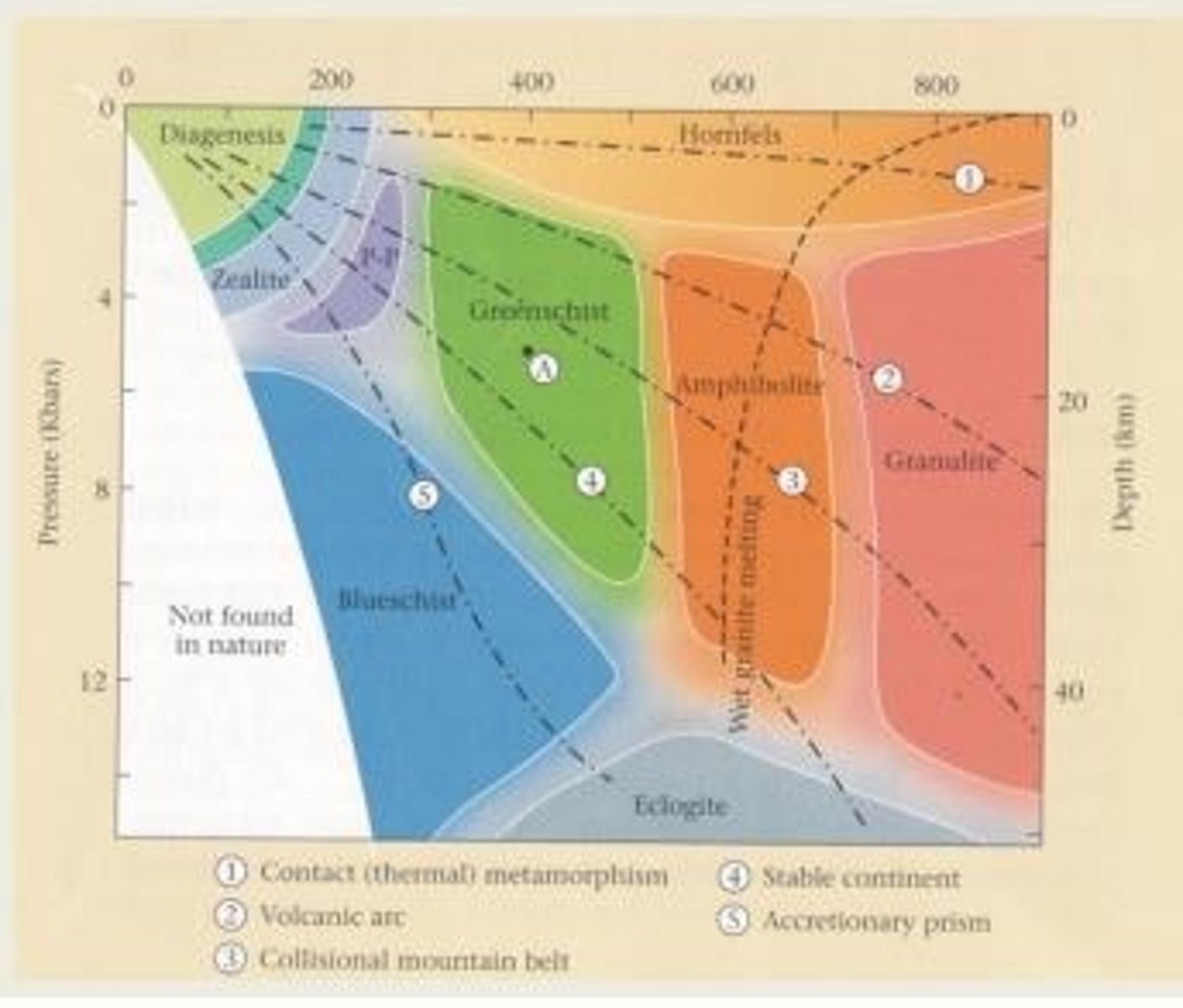Geology Chapter 7
1/21
There's no tags or description
Looks like no tags are added yet.
Name | Mastery | Learn | Test | Matching | Spaced |
|---|
No study sessions yet.
22 Terms
According to this metamorphic facies graph, which of the following statements is TRUE?
A. Blueschist facies rocks form at high pressures and low temperatures.
B. Hornfels facies rocks form in a narrow range of temperature conditions (<400°C).
C. Greenschist facies form at depths greater than 35 km.
D. The highest pressure facies indicated on this graph is the hornfels facies.
A.

Choose the listing that shows the rocks in increasing degrees of metamorphism (i.e., from lower to higher grade).
A. migmatite, metaconglomerate, gneiss
B. metaconglomerate, gneiss, migmatite
C. gneiss, metaconglomerate, migmatite D. gneiss, migmatite, metaconglomerate
B.
Identify the FALSE statement. Hydrothermal fluids
A. may consist of hot water, gases, or supercritical fluids.
B. can accelerate metamorphic reactions.
C. change a rock's chemical composition, a process known as exhumation.
D. can be derived from groundwater or magma, or can be the product of metamorphic reactions.
C.
Metamorphic aureoles typically contain nonfoliated rock like hornfels because
A. they form adjacent to an intruding pluton, which provides heat for metamorphism.
B. they form as a consequence of shearing without a subsequent change in temperature or pressure.
C. compressional forces associated with mountain building provide the necessary pressure to create hornfels.
D. they form at shallow burial depths (less than 8 km).
A.
Quarzite.......
A. is basically a solid mass of interlocking quartz grains.
B. breaks around the separate grains of quartz that make it up.
C. is always either white or gray.
D. always shows strong compositional banding.
A.
Recrystallization.....
A. occurs when rocks become warm enough that they behave like soft plastic.
B. results in the growth of new minerals that differ from the protolith.
C. changes the texture (shape and size) of the grains.
D. is a process by which grains push against one another, creating dissolution.
C.
Tension (a type of stress)
A. is created by a pull perpendicular to a surface.
B. is the reason a balloon collapses when you take it to the bottom of a pool.
C. occurs when rocks move sideways relative to each other.
D. is a compression exerted equally from all sides.
A.
What is the protolith of marble?
A. quartz sandstone
B. limestone
C. phyllite
D. gypsum
B.
What type of foliation does slate, a common material used for roof shingles, exhibit?
A. banding
B. cleavage
C. schistosity
D. metamorphic differentiation
B.
Which is NOT a common process by which metamorphic rocks are formed?
A. pressure solution
B. plastic deformation
C. schistosity
D. recrystallization
C.
Which of the following does NOT describe a change induced on protolith rocks due to mountain building as a result of convergent-margin tectonics and continental collision?
A. Surface rock is sent to great depths beneath the new mountain belt.
B. The once surface rock heats up due to igneous activity and the geothermal gradient.
C.. Hot magma rising beneath the converging continents heats seawater, which then rises through the crust to react with the surface rocks.
D. Compression and shearing metamorphose the once surface rock.
C.
Which of the following is NOT a common metamorphic facies?
A. greenschist
B. blueschist
C. granulite
D. mafic
D.
Which of the following locations could not possibly be part of a shield?
A. Hawaii
B. Canada
C. Northern Europe
D. Siberia
A.
Which of the following metamorphic processes is where spherical grains dissolve on the sides that undergo significant pressure and new mineral material precipitates where the pressure is low?
A. plastic deformation
B. recrystallization
C. neocrystallization
D. pressure solution
D.
Which of the following rocks is classified as nonfoliated?
A. hornfels
B. phyllite
C. slate
D. schist
A.
Which of the following statements about metamorphic rocks and their characteristic environments is TRUE?
A. Gneiss is found in metamorphic aureoles surrounding plutons.
B. Mylonites are found along convergent plate boundaries where magma is rising.
C. Slate, phyllite, schist, and gneiss are found in areas of continental collision.
D. Blueschists are found in the mid-ocean ridge.
C.
Which of the following statements is FALSE? A metamorphic rock
A. may be composed of different minerals than its protolith.
B. may develop a texture of interlocking grains.
C. cannot be formed below 1200°C.
D. may have preferred mineral orientation caused by differential stress.
C.
Which of the following statements is FALSE? Dynamic metamorphism
A. may happen as uplift and erosion bring rock closer to Earth's surface.
B. occurs as a consequence of shearing.
C. requires very high pressures but needs only low temperatures to occur.
D. happens under conditions of decreasing temperature and pressure.
B.
Which of the following statements is FALSE? Mylonite
A. forms by recrystallization in a fault zone.
B. is produced by shear stress on softened rock.
C. has pronounced foliation parallel to the direction of faulting.
D. is a product of gneiss melting to produce felsic magma and solid mafic rock.
D.
Which of the following statements is FALSE? Shields
A. are composed of some of the oldest rock on Earth (Precambrian).
B. are composed of extensive areas of sedimentary layers laid down on lava flows.
C. are composed of rocks that were metamorphosed during ancient mountain-building events.
D. make up large areas of Canada, southern Africa, and South America.
B.
Which of the following statements is FALSE? Shock metamorphism
A. involves high temperatures and compressional stress.
B. can be caused by meteorite impact.
C. causes quartz to recrystallize into coesite.
D. results from the process of exhumation.
D.
Which of the following statements is FALSE? The extremely high heat of metamorphism.
A. can cause some felsic minerals to begin to melt.
B. can produce banding by metamorphic differentiation.
C. is necessary to form migmatite.
D. is necessary to elongate the large clasts in conglomerate to make metaconglomerate.
D.